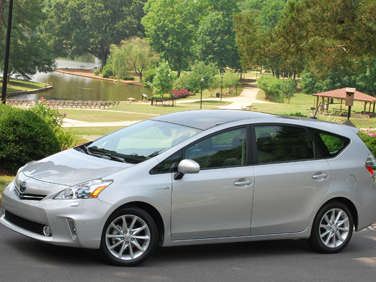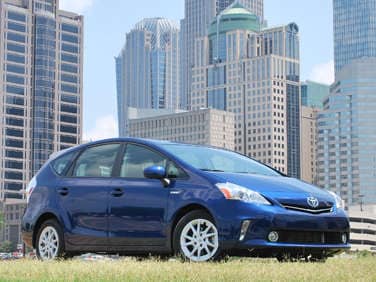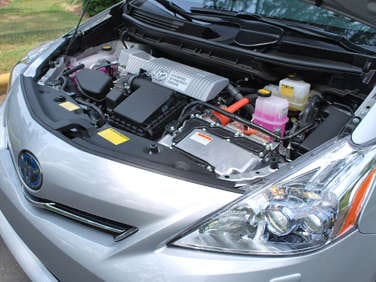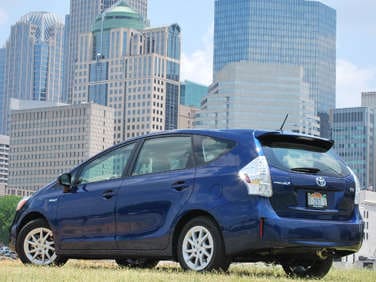Recent Articles
Popular Makes
Body Types
2012 Toyota Prius v First Drive Review

If Toyota thought pluralizing the Prius name was tough for most consumers, then defining the 2012 Toyota Prius v (pronounced “vee”) will be even more challenging – which, in this case, is a smart move. With American buyers largely still against the idea of buying minivans, station wagons or hatchbacks, Toyota designed its all-new, family-friendly Prius v to excel in many areas including fuel economy, passenger space, cargo space and cabin technology. After all, the automaker says that the “v” in Prius v stands for versatility. Assembled in Japan alongside the Prius hatchback, the 2012 Toyota Prius v will go on sale this fall, and although pricing has yet to be finalized, the starting MSRP is expected to be in the mid- to upper-$20,000 range. At that price, Toyota should have no problem achieving its goal of selling around 20,000 Prius v models annually. Eventually, Toyota hopes that the Prius nameplate will be its top-selling vehicles – a position currently held by the Toyota Camry and Toyota Corolla. For now though, no matter how you say it (Priuses or Prii), Toyota may have finally come up with the perfect family vehicle that doesn’t sacrifice size, comfort or price for fuel economy.
2012 Toyota Prius: Exterior
At a quick glance, it’s really hard to distinguish the Prius v from the smaller Prius hatchback, but the new model has grown in just about every dimension while keeping the same proportions and wedge-shaped profile. Toyota managed to hide the v’s extra length with an arched roofline and a very stylish side greenhouse. The squared-off edges of the front and rear fascias keep the Prius v from appearing too round, but these elements also help improve aerodynamics. Like the Prius, Toyota prides itself on the drag coefficient of the Prius v which is 0.29 making it one of the sleekest mid-size vehicles on the market. Details such as the small fins in the headlights and the rear liftgate spoiler further give the Prius v its slippery shape. In terms of overall styling, the Prius v has the front end of a minivan and the back half of a crossover. The sloped hood and raked windshield give the Prius v a recognizable look, but the rounded D-pillars and tall, LED taillights give it a unique appearance even compared to the standard Prius. In profile, the width of the rear doors is apparent hinting at the extra space now available to rear-seat passengers. The easiest ways to tell the Prius v Five apart from the other models are the headlights, fog lights and the 17-inch alloy wheels. This trim level adds LED headlights with a self-leveling control, while the other two models have projector beam halogen headlights. For wheels, the Prius v Two comes with 15-inch steel wheels while the Prius v Three adds 16-inch alloy wheels.

2012 Toyota Prius: Interior and Safety
Markets outside of North America will offer three-row seating from this upsized Prius, but the 2012 Toyota Prius v heading to the United States will only be available with a five-passenger seating configuration. Toyota says this was done to avoid a cramped third-row seat, but it is also helpful in preventing this new model from stepping on the toes of the seven-passenger Toyota Highlander Hybrid. While Toyota refused to label the new Prius v, it did say that this new model offers the same passenger space as a mid-size sedan with almost the same amount of cargo space of a mid-size crossover (and 54 percent more cargo capacity than a Prius). The 2012 Toyota Prius v will be available in three trim levels – Prius v Two, Prius v Three and Prius v Five – and we were able to test out the two upper trim level models. All passengers get added headroom and legroom, but the rear passengers are more likely to notice the extra space. Not only is there more room, but the rear seat is also able to slide fore and aft as well as recline up to 45 degrees. One of the main highlights of the larger interior is the improved cargo volume which varies between 34.3 cubic feet with the rear seats in place up to 67.3 cubic feet with the seats folded flat; comparatively speaking, the Toyota RAV4 offers up to 73 cubic feet and the mid-size Toyota Highlander offers up to 95.4 cubic feet. Storage areas are also plentiful with dual glove boxes and a large center console. The only downfall of the center console is the side-hinged cover that makes it challenging for a passenger to retrieve items from the storage compartment. Some of the more innovative features include the unique HVAC controls which uses a large central dial to control three separate functions (mode, fan speed and temperature) and a stowable rear cargo cover which allows the vinyl cover to be placed under the cargo floor when not in use. Of course the coolest new feature on the Prius v is the Microsoft-developed Entune system that brings smartphone apps into the cabin. This system pairs the audio system with a phone to provide a variety of services such as Bing, iheartradio, Pandora, OpenTable and movietickets.com. In the future, more apps are likely to be offered. Two different head units allow for Entune on the Prius v: a 6.1-inch screen on the Prius v Three and a 7.1-inch touchscreen display with navigation on the Prius v Five. By the end of this year, Entune will also be available on the Camry and Tacoma. Like the rest of the vehicle, Toyota focused on maximizing the efficiency of the Prius v by reducing the weight of many of the components. The optional dual-pane panoramic roof offered on the Prius v Five not only weighs about 40 percent less than regular laminated glass, it also helps to keep cabin temperatures down meaning the air conditioning doesn’t have to run as frequently. Both models we tested were equipped with Toyota’s SofTex which is a lightweight material that looks and feels like leather but weighs 50 percent less and requires fewer chemicals to produce than synthetic leather. Toyota also says it is easier to clean and resists wear and tear better than conventional leather. Even the premium JBL audio system weighs less while using less energy. Official crash test scores probably won’t be available until after the launch of the Prius v, but it does come standard with plenty of safety features such as seven airbags, active front head restraints, daytime running lights, tire pressure monitoring system, and Toyota’s Star Safety System which consists of electronic brake-force distribution with brake assist, four-wheel anti-lock disc brake system, traction control and Vehicle Stability Control.

2012 Toyota Prius: Performance
Both the Prius and the 2012 Toyota Prius v share the same components when it comes to Toyota’s Hybrid Synergy Drive system but Prius v makes some minor changes for improved driveability. The engine is still the same 1.8-liter inline-four producing 98 horsepower and 105 lb-ft of torque, but Toyota has re-engineered the exhaust heat recirculation system to allow the engine to warm up faster to run at a more efficient temperature. Similarly, the electronically controlled continuously variable transmission (eCVT) features different gear ratios to account for the extra 232 pounds in curb weight. Even the electric drive system carries over the same electric motor and nickel-metal hydride battery, but the battery pack has been redesigned to be smaller and feature new air vents for better cooling. The total output of the hybrid system is still 134 hp and the Prius v can operate under full electric power at low speeds for about a mile. The biggest difference between the powertrain of the Prius and the Prius v is the fact that Toyota recommends that the Prius v run on 91 octane (premium unleaded) gasoline. Still, Prius v owners won’t be making frequent gas stops with what it sure to be impressive fuel economy numbers. Official EPA fuel economy estimates have not yet been released for the new Prius v, but Toyota expects its new hybrid people mover to return 44 miles per gallon in the city and 40 mpg on the highway with a combined rating of 42 mpg. During the drive, we averaged pretty close to these figures in short test routes in Charlotte, N.C. using the Eco driving mode, but the Hybrid Synergy Drive system also has EV, Power and Normal modes geared for different road conditions and preferred driving styles. Another change Toyota made to the Prius v was the front suspension mounting points in an effort to improve the ride and handling with the heavier weight and taller center of gravity. This revised suspension gives the Prius v a ride more like a passenger sedan than a tall crossover, but one of the more advanced features to debut under this new hybrid is Toyota’s Pitch and Bounce Control system. When traveling over wavy roads, the system to prevent the car from bouncing up and down along the road. This ultimately provides better passenger comfort and better driver control. We weren’t able to test this feature in short test routes in Charlotte, N.C., but the rest of the suspension setup was surprisingly balanced offering a smooth ride for passengers without feeling too numb in cornering maneuvers. This balance is due to the MacPherson front struts, torsion beam rear suspension and the electric power-assisted steering system. Like all Toyota hybrids, the Prius v will have a five-year/60,000-mile powertrain warranty and an eight-year/100,000 hybrid component warranty.

2012 Toyota Prius: Summary
One of the weak points of the recognizable Toyota Prius has always been its interior space, so the 2012 Toyota Prius v makes a few simple recipe changes to deliver more passenger and cargo volume. In addition to the larger interior space, Toyota is also equipping the new Prius v with plenty of new cabin technology while including the same hybrid technology that delivers impressive fuel economy. The versatile new Prius v manages to combine the best aspects of a crossover and a minivan, but Toyota makes a point not to place any labels its newest model other than calling it a mid-size hybrid. Toyota is intentionally not labeling its all-new Prius v which means customers could likely cross shop it against a wide variety of vehicles including the Ford Escape Hybrid crossover, Mazda MAZDA5 compact minivan and even the Volkswagen Jetta Sportwagen TDI station wagon. In one vehicle, Toyota has managed to provide the best aspects of a crossover, a station wagon and a minivan while simultaneously giving it the instantly recognizable shape and name of the iconic Prius hatchback. The 2012 Toyota Prius v is just the first step in expanding the Prius family of hybrids, and the Prius c hatchback and Prius plug-in are both expected to debut in 2012. Being such an economical and versatile family car, the Prius v is a great start toward attaining this goal.
- Cabin tech including Entune; crossover-like passenger and cargo space; superior fuel economy for mid-size family cars
- Awkwardly hinged center console lid; confusing trim level naming system;
Toyota provided travel, lodging and vehicle for this review. Photos by Jeffrey N. Ross
